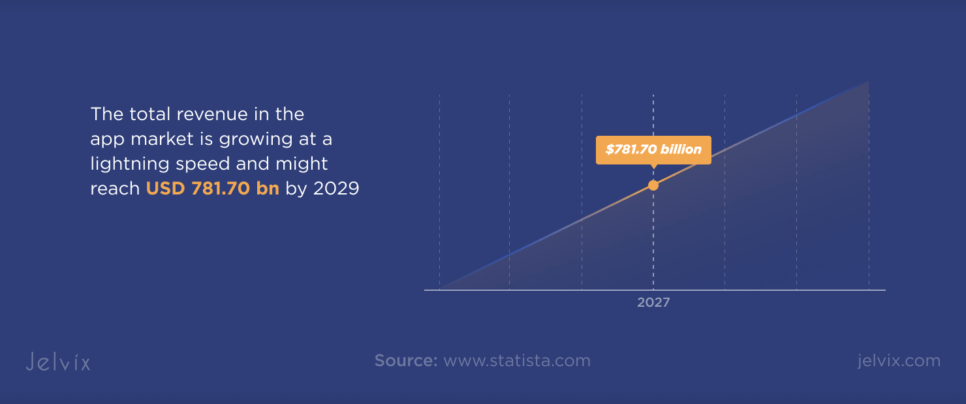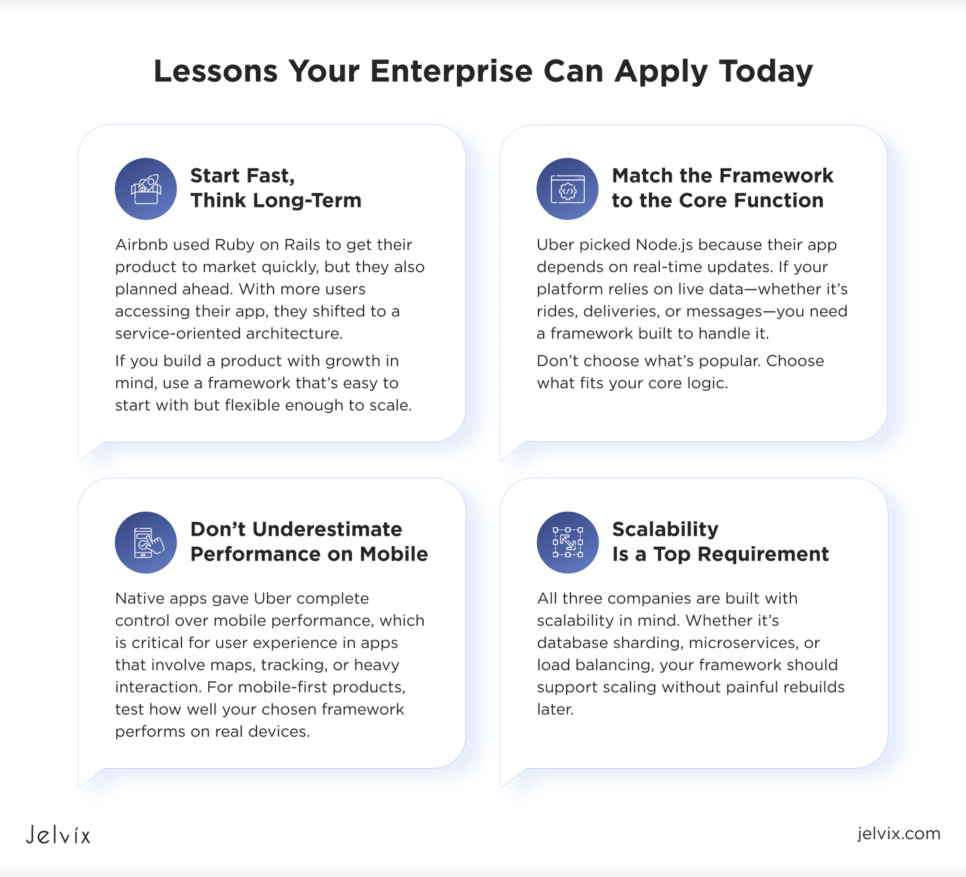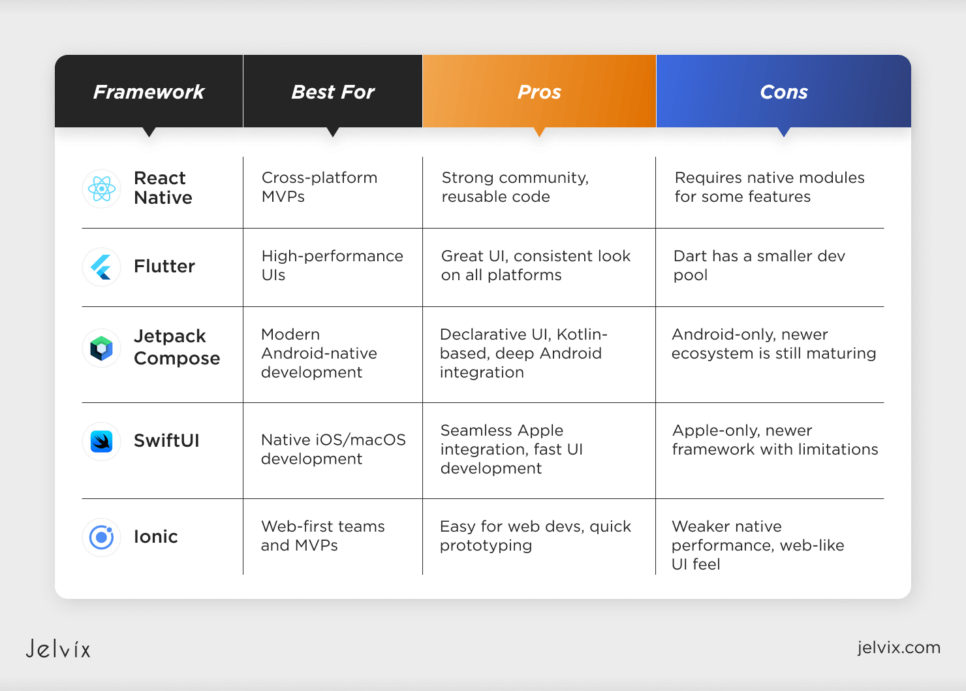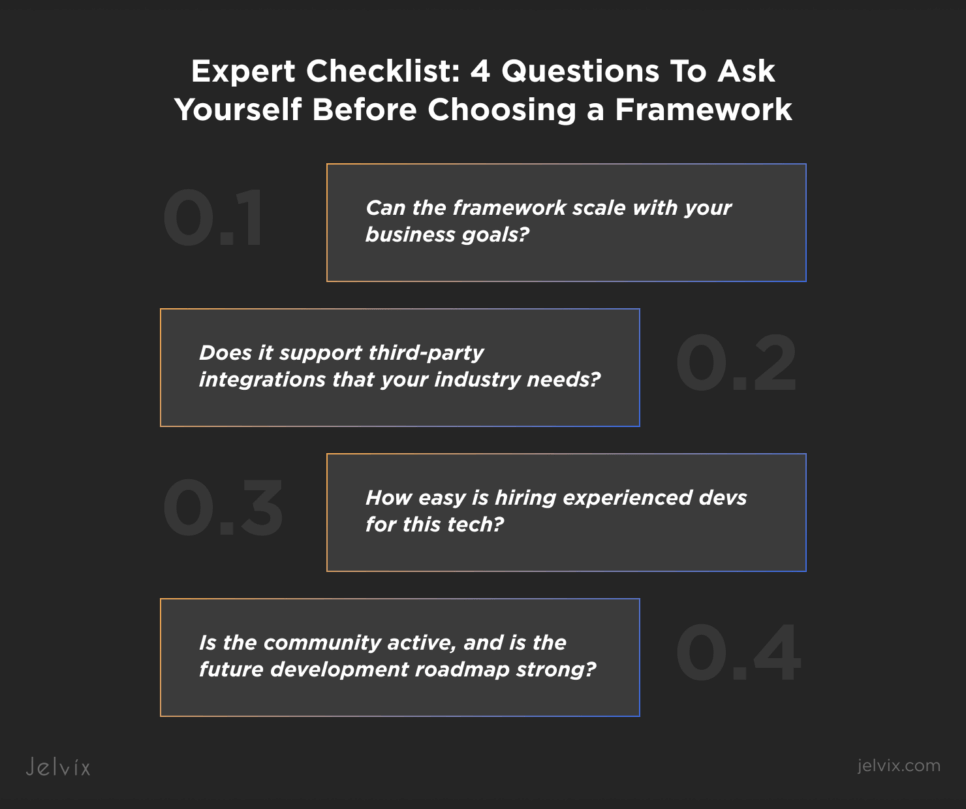Modern consumers seek convenience in everything, from daily communication and booking trips to receiving medical services. Businesses respond to this need by creating possibilities for their clients to get everything they want in a few clicks, and many build apps to deliver services faster.
The total revenue in the app market is growing at a lightning speed and might reach USD 781.70bn by 2029. But despite all the benefits, developing a modern app for your business can be tricky. It’s not enough to make it work right now—it needs to scale, operate on all devices, and keep users happy, whatever happens. And to achieve that, you need to choose the proper tech stack.
If you want to build an app like Airbnb, Uber, or Teladoc but aren’t entirely sure which framework to choose, read this guide. You’ll find out what frameworks are available on the market and how to pick the one that won’t lead to higher costs, delays, and technical debt.
What Is a Web Development Framework?
A framework is a set of tools and building blocks developers use to create apps faster. It saves time by offering pre-written code for standard features like user login, navigation, and data handling. A good framework helps your team move faster, avoid bugs, and stay consistent throughout application development.
Types of Frameworks: Native, Cross-Platform, and Hybrid
There are three key types of frameworks you can select from, and the right choice depends primarily on what kind of app you’re building and how fast you want it to scale.
Native frameworks are made for just one platform, like Swift for iOS and Kotlin for Android. They offer top performance but require building two separate apps if you want to be present on various devices.
There’s an option to use a single codebase that works for both iOS and Android, and you need a cross-platform framework like React Native or Flutter for that. It can save you time and money, and it usually offers excellent performance.
Hybrid frameworks like Ionic are basically web apps inside a mobile shell. They’re easy to build but often work more slowly and look less polished.
Learn more about the differences between native and cross-platform app development to choose the best approach for your project.
Key Features To Look for in Mobile Development Frameworks
It’s not easy to ensure that the chosen framework is suitable for your needs when you don’t know much about this tech. It can be a good idea to learn more about the key features a good framework should have.
Performance is one of the critical characteristics for your framework. It doesn’t matter if you build a food delivery, a real estate, or a medical app. It must be fast and able to handle complex features without slowing down.
What’s more, you need to be prompt in software product development to launch and improve quickly. So, look for a framework that helps your team work fast, especially if you’re building an MVP.
Your app also needs to keep up with the growing user base. A good framework should let you scale easily without needing to rebuild everything from scratch. And if you want your app to work on iOS and Android, choose a framework that supports both without doubling the workload.
Another thing to think about is safety. If your app handles sensitive info like medical records or payment data, the framework should support strong security options like role-based access controls and two-factor authentication.
Learning from Top Apps: What They Do Right
As of 2024, Airbnb handled over 490 million bookings, which resulted in their revenue reaching about USD 11 billion the same year. One of the reasons for such success was a wise tech choice, including a suitable framework.
Airbnb started with a Ruby on Rails backend, which allowed them to build and launch quickly. For the frontend, they later adopted React Native to improve UI performance. As their platform scaled, they shifted toward a service-oriented architecture for better maintainability. On the mobile side, Airbnb moved away from React Native and rebuilt its apps using native technologies like Swift for iOS to improve performance and stability.
Uber is another prominent example of how a correct tech stack can help reach stunning business results. Just within the first 10 years of its existence, Uber became one of the top services in its niche, serving about 150 million users monthly.
Since Uber’s core functionality depends on real-time communication and fast response times, developers chose Swift and Kotlin to build native apps for iOS and Android. This helped ensure smooth performance and full access to device features like geolocation and push notifications. Later, they developed custom backend tools to manage their complex data flow.
Speaking of healthcare software development, Teladoc operates in a highly regulated environment, so it has been focusing on backend reliability, patient data protection, and HIPAA compliance since the very beginning. Their tech stack includes enterprise-level technologies like .NET and Java, which support strong encryption and scalable architecture. Their systems are API-driven to enable integrations with healthcare providers, insurance systems, and internal platforms.
Lessons Your Enterprise Can Apply Today
Given the success of previously described apps, your company can adopt their best practices to support its growth and make sure that the app development cost remains adequate.
Start Fast, Think Long-Term
Airbnb used Ruby on Rails to get their product to market quickly, but they also planned ahead. With more users accessing their app, they shifted to a service-oriented architecture. If you build a product with growth in mind, use a framework that’s easy to start with but flexible enough to scale.
Match the Framework to the Core Function
Uber picked Node.js because their app depends on real-time updates. If your platform relies on live data—whether it’s rides, deliveries, or messages—you need a framework built to handle it. Don’t choose what’s popular, choose what fits your core logic.
Don’t Underestimate Performance on Mobile
Native apps gave Uber complete control over mobile performance, which is critical for user experience in apps that involve maps, tracking, or heavy interaction. For mobile-first products, test how well your chosen framework performs on real devices.
Scalability Is a Top Requirement
All three companies are built with scalability in mind. Whether it’s database sharding, microservices, or load balancing, your framework should support scaling without painful rebuilds later.
Examples of Frameworks Used in Industry-Leading Apps: An Overview
There are many frameworks out there, and some have already helped top applications deliver excellent performance, scale fast, and build across platforms. Below is a quick overview of the most widely used frameworks that you might find useful for your business app.
React Native: Seamless Cross-Platform Development
The React Native framework lets you write code once and launch on both iOS and Android. It uses JavaScript and shares logic between platforms at the same time, allowing some native customization when needed. It better suits startups and businesses that want fast development across platforms without sacrificing too much performance.
Flutter: High Performance and Stunning UI Design
Flutter uses Dart and comes with its own rendering engine, which helps create smooth animations and beautiful interfaces that look the same on all devices. Apps that need a rich UI and fast performance on iOS and Android will benefit the most from this framework.
Xamarin: Enterprise-Level Integration
Xamarin, built on C#, was once a solid choice for building cross-platform apps, especially for custom enterprise software using Microsoft’s ecosystem. It offered smooth integration with .NET-based backends and strong support for internal business apps.
However, Microsoft officially ended support for all Xamarin SDKs in May 2024, making it a deprecated solution. Most companies are transitioning to .NET MAUI or other supported frameworks.
SwiftUI: Optimized for Apple Ecosystem
SwiftUI is Apple’s modern framework for building native iOS apps using a declarative Swift syntax. It offers smooth integration with Apple services and delivers high performance along with a smooth, native user experience. SwiftUI is ideal for businesses targeting iPhone or iPad users who expect fast, elegant, and responsive apps.
Jetpack Compose: Built for Android
For Android development, an approach similar to SwiftUI is offered by Jetpack Compose, a Kotlin-based framework for building native UIs with a declarative structure. Both are now considered the standard for modern native mobile UI development on their respective platforms.
Ionic: Ideal for Web-Based Mobile Apps
Ionic is based on HTML, CSS, and JavaScript. It wraps your app in a native shell, making it feel like a mobile app, but under the hood, it remains a web app. Teams with strong web development experience or MVPs that don’t require full native performance can find Ionic perfect for their needs.
Learn more about key software development roles and how each contributes to building successful digital products.
Jelvix Expert Tips for Choosing the Right Mobile App Framework
Choosing a framework for your app is a core decision that impacts its performance and ability to grow. Experts from Jelvix suggest that you follow a few tips to select exactly what you need.
Aligning Framework Selection with Business Goals
Start by focusing on what your app needs to achieve. If you’re building an MVP and want to launch fast across both iOS and Android, frameworks like React Native or Flutter can work, especially for simpler apps with limited use of native APIs. However, for projects with deeper system integration or more complex performance needs, cross-platform tools often fall short.
In many modern setups, teams go with SwiftUI by Swift for iOS and Jetpack Compose by Kotlin for Android. Both are now considered the native standard for building high-quality and responsive mobile apps on their platforms. Choosing the right combination depends on your audience, tech requirements, and how far you plan to scale the product.
Scalability for Growing Enterprises
A framework should support you as you grow. Scalability includes backend flexibility, performance under load, and the ability to split services as needed. Frameworks like Flutter and React Native can scale with the right architecture behind them and support your growth goals.
Evaluating Team Expertise and Resources
If you’re deep into Microsoft tools, .NET MAUI may offer easier integration. It builds on the legacy of Xamarin but provides improved cross-platform support and long-term maintainability.
Ensuring Long-Term Maintenance and Support
A strong community and regular updates can make a big difference. Look at the framework’s stability, how often it’s updated, and whether it has active community support. For instance, React Native and Flutter are actively maintained and backed by tech giants, while SwiftUI is evolving fast, but mainly within Apple’s ecosystem.
When To Prioritize Scalability, Security, or Rapid MVP
If you’re building within Microsoft’s ecosystem and need robust security, .NET MAUI combined with Azure services can be a strong foundation.
Framework Comparison: Features, Pros, and Cons
The table below provides a comparison of popular frameworks and their core functionality.
Real-Life Examples of Framework Success
Choosing the correct framework can directly impact how fast your product grows, how stable it runs, and how easy it is to update.
How Swift and Kotlin Power Airbnb’s Seamless Experience
Airbnb’s transition to native development offers a strong lesson for apps that rely heavily on performance and real-time features. By migrating to native frameworks like SwiftUI (and Jetpack Compose for Android apps), they gained more control over app behavior, enabling smoother animations and improved stability—especially in complex user flows like booking, messaging, and map interactions.
For platforms in travel, real estate, or marketplace apps, this approach can help deliver a polished, responsive experience that scales well with user growth.
Flutter’s Role in Building High-Performance Apps Like Teladoc
Flutter’s fast rendering and customizable UI make it a strong choice for healthcare apps that need consistent performance across devices. Platforms like Teladoc benefit from the same advantages that Flutter offers — smooth video calls and real-time updates in a single codebase.
How CTOs Pick Mobile App Development Frameworks
Since frameworks make a huge business impact, CTOs usually balance tech requirements with product goals, budgets, and long-term vision.
Leveraging Community Support and Plugins
A strong developer community saves time and reduces risk. CTOs often pick frameworks with mature ecosystems for stability and ready-to-use libraries and tools. A rich ecosystem shortens development time and helps resolve issues faster.
Optimizing Performance Across Platforms
Cross-platform isn’t always enough, as the experience has to feel native. CTOs look at how each framework performs under real-world usage. Mobile apps with live tracking or real-time video communication must be smooth and responsive across all devices.
Integrating Emerging Technologies
Future-proofing matters. If the roadmap includes AI-driven features, connected devices, or immersive user experiences, the framework needs to support that. The right one will make it easier to plug in new tech as your product evolves.
Total Cost of Ownership and Time-to-Market
CTOs measure both build cost and long-term value. A framework that’s fast to launch but hard to maintain can become a liability. Framework choice affects scaling, testing, and release cycles, and not just the first version of the app.
Security, Compliance, and Maintainability
Security is non-negotiable in sectors like healthcare, finance, and government. CTOs review whether a framework can support HIPAA, PCI-DSS, and security measures like authentication, encrypted storage, and audit logs. Maintainability also means clean codebases, test automation support, and regular updates.
Expert Checklist: 4 Questions To Ask Yourself Before Choosing a Framework
Before you select a framework, make sure it can support your needs. Ask yourself a few important questions that will help you make the correct choice.
Can the framework scale with your business goals?
Look for a framework that supports modular architecture, backend flexibility, and performance tuning. It must still perform well when you have ten times more users, data, and features.
Does it support third-party integrations that your industry needs?
Asses if you need payment gateways, video calls, healthcare APIs, or maps. Check that the framework offers stable and well-documented plugins or SDKs for your critical tools.
How easy is hiring experienced devs for this tech?
Avoid frameworks that no one knows how to work with. Using a rare or niche framework might slow hiring or increase costs. In contrast, popular choices like React Native and Flutter have wide developer communities.
Is the community active, and is the future development roadmap strong?
A strong roadmap means better long-term support. Look at GitHub activity, recent releases, and contributions from the core team or company backing it. The framework must constantly stay updated with all bugs fixed.
The Future of Mobile Frameworks: Trends To Expect in 2025
Just like any other tech, frameworks are changing, offering new features and possibilities for growth. You need to be aware of these changes so as not to miss core updates and innovations.
AI Integration, Edge Computing, and Backend Extensibility
Frameworks are starting to support more advanced use cases. Built-in AI tools and edge computing are becoming common in apps that need fast response or offline support. On the backend, extensibility is key, as teams want frameworks that easily connect with APIs, cloud services, and microservices.
Low-Code and No-Code in Enterprise Environments
The market of low-code and no-code tools might surpass USD 94 billion by 2028, and even big companies use them to build simple apps or internal solutions faster. This trend helps companies launch quicker, especially for non-customer-facing tools like admin dashboards or reports.
Frameworks with Web3 and Blockchain-Based Apps
More developers are building apps with Web3 technologies, like blockchain, smart contracts, and crypto wallets. Frameworks that support these features out of the box, or work well with tools like Web3.js and wallet integrations, are on the rise. These include mobile frameworks like Flutter and React Native, which are now being used in crypto wallets, NFT apps, and decentralized platforms.
Final Thoughts: Making a Smart Investment in Mobile Apps Development
The right framework should match not just what you need right now, but also your future goals. If growth, performance, or integrations are part of your growth strategy, your tech stack needs to support that from the start.
Working with experienced development partners can make framework decisions easier. At Jelvix, we bring real-world insight, help avoid common mistakes, and guide your team through scaling, compliance, and long-term maintenance. If you need help choosing a framework, want to develop an app from scratch, or wish to integrate an existing one, reach out to our professionals. We will answer any questions you might have.
Need reliable developers?
Access a full-cycle development team tailored to your business needs.













